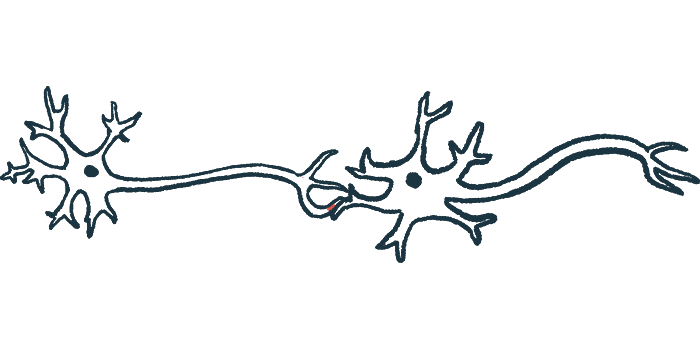Immune Cells Found to Cooperate to Fight Toxic Protein Clumps

Immune cells in the brain responsible for breaking down the toxic protein clumps, or aggregates, that lead to nerve cell death in Parkinson’s disease join together to form networks to share the burden, a study showed for the first time.
These networked cells also share energy-producing mitochondria to help neighboring cells stressed by the aggregate breakdown process, the study found.
However, the scientists noted that cells that carry a common Parkinson’s-related mutation were less efficient at cooperating — which may represent a disease-causing factor by which mutations cause familial Parkinson’s disease.
“These data identify a mechanism by which [immune cells] create an ‘on-demand’ functional network in order to improve [disease-causing protein clump] clearance,” the researchers wrote.
This cooperation helps the immune cells to “better cope with threats,” the scientists said in a press release.
“We have opened the door to a field that will certainly engage researchers for many years to come,” said Michael Heneka, MD, PhD, the study’s lead author and the director of the department of neurodegenerative diseases and geriatric psychiatry at the University Hospital Bonn, in Germany.
The study, “Microglia jointly degrade fibrillar alpha-synuclein cargo by distribution through tunneling nanotubes,” was published in the journal Cell.
In Parkinson’s, nerve cells (neurons) that produce the signaling molecule dopamine are damaged due to the buildup and aggregation (clumping) of the protein alpha-synuclein. A lack of dopamine results in the characteristic motor symptoms of Parkinson’s, such as tremors, slow movements, and muscle rigidity, and non-motor symptoms, including cognitive impairment and depression.
Immune cells of the brain — known as microglial cells — are responsible for breaking down and disposing of such alpha-synuclein clumps. When activated, microglial cells execute an inflammatory response that, if sustained, leads to ongoing inflammation and nerve cell damage, which is commonly found in the brain of Parkinson’s patients.
However, the exact mechanism by which microglial cells remove alpha-synuclein clumps remains unclear.
In this joint study, conducted in the laboratories at the University of Bonn and the Institut François Jacob in France, researchers now examined how microglial cells clear alpha-synuclein aggregates and whether microglia survival is affected by exposure to these toxic protein clumps.
First, isolated microglial cells exposed to alpha-synuclein clumps ingested the aggregates and triggered inflammation- and cell death-related pathways within the cell. When removed from the aggregate environment, up to 50% of the clumps remained undegraded by microglial cells.
Notably, unexposed (naive) microglia spontaneously joined together with aggregate-exposed cells via tube-like projections making membrane-to-membrane contacts. Over time, the aggregates within cells were transferred and distributed among the unexposed microglia. Even though naive cells formed some contacts, the presence of toxic protein clumps stimulated more microglia-to-microglia connections.
Following the cell-to-cell transfer of aggregates, experiments showed that the inflammatory pathways enhanced by alpha-synuclein clumping were down-regulated. Moreover, pathways that supported microglia-to-microglia connections initially stimulated within the first hour of co-culture declined over time.
Challenging cells with alpha-synuclein clumps eventually led to the death of microglia, which was largely reduced by co-culturing with unexposed cells.
At the same time, the aggregate challenge also triggered the degradation of energy-producing mitochondria, resulting in increased production of reactive oxygen species (ROS) — highly reactive chemicals formed from oxygen that causes damage to cells. When co-cultured with naive cells, the production of ROS was reduced.
Further experiments revealed the presence of mitochondria and alpha-synuclein inside the cellular connections and that unexposed microglial cells transferred mitochondria to cells with aggregates.
“These data show that [alpha-synuclein]-loaded microglia transfer [alpha-synuclein] to naive microglia and, in parallel, receive functionally intact mitochondria from the acceptors, thereby escaping from cytotoxicity and cell death,” the researchers wrote.
“They then send mitochondria to neighboring cells that are busy breaking down the aggregates,” said Hannah Scheiblich, PhD, the study’s first author and a post-doctoral researcher at the University of Bonn.
“Mitochondria function like little power plants,” Scheiblich said, “so they provide extra energy to the stressed cells.”
A mutation in the LRRK2 gene, called G2019S, is a common genetic-related cause of Parkinson’s and has been associated with the impairment of mitochondria. Microglial cells that carried this mutation were significantly less efficient in transferring aggregated alpha-synuclein from affected cells to naive acceptor cells without mutations. When only LRRK2 microglia were used, the redistribution of alpha-synuclein clumps led to the doubling of toxic ROS.
Importantly, LRRK2 cells containing aggregates co-cultured with normal, naive acceptor cells significantly reduced their ROS production. Likewise, mitochondria transfer was impaired between LRRK2 cells, but not when LRRK2 cells were grown with unmutated acceptor cells.
“Microglia carrying the LRRK2 G2019S mutation were not able to rescue neighboring cells, thereby inducing their own ROS level,” the researchers wrote. “These results indicate that dysregulated [alpha-synuclein] degradation in LRRK2 mutant microglia may represent one pathogenic [disease-causing] factor by which mutations within LRRK2 cause familial [Parkinson’s disease].”
Microglial cells containing alpha-synuclein were injected into slices of brain tissue isolated from mice to determine whether these findings occurred in tissue. Not only did connections form between injected cells and mouse cells, but the team also found alpha-synuclein inside mouse microglial cells, “suggesting a transfer of [alpha-synuclein] from the injected to the tissue-resident microglia,” the researchers added.
Finally, the team examined post-mortem [taken after death] human brain tissue samples of patients with dementia due to alpha-synuclein clumping. They saw several microglia filled with aggregates, and many were connected by alpha-synuclein-containing cell-to-cell connections.
Based on these results, certain immune cells known as macrophages were isolated from the blood of affected patients, and from unaffected healthy people, used as controls. They converted them to microglia-like cells with exposure to specific regulatory molecules.
Cell-to-cell connections were confirmed between cells exposed to aggregates and naive acceptors. Still, they resulted in a significantly lower transfer rate of alpha-synuclein in patient-derived cells compared with healthy individuals. Again, exposure of patient-derived cells to aggregates significantly elevated the ROS production, “thus indicating that ROS might influence the transfer of [alpha-synuclein] between cells,” the scientists wrote.
“Together, our data present evidence that microglia have the ability to actively connect to neighboring cells to share the amount of cytotoxic protein accumulations e.g., as a strategy to provide aid and support of protein degradation and to attenuate inflammatory reactions,” the researchers concluded.
“Future studies will have to investigate whether similar contacts and mechanisms exist between microglia and neurons,” they added.








